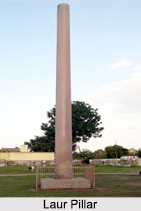 The Mauryan period was the time of great development in art and architecture. The pillars erected by Ashoka furnish the finest specimen of the Mauryan art. The tops of these pillars were crowned with the figures of animals like lion, elephant and bull. Though, some of the Ashokan pillars are devoid of a capital, which means it lacks the 3 main constituents- bell, abacus and an emblem. The lofty stone column of Ashoka, known as Laur Pillar in Lauriya Areraj is a fine example of this kind of architecture. The Archaeological Survey of India has classified this Ashokan pillar as a protected monument.
The Mauryan period was the time of great development in art and architecture. The pillars erected by Ashoka furnish the finest specimen of the Mauryan art. The tops of these pillars were crowned with the figures of animals like lion, elephant and bull. Though, some of the Ashokan pillars are devoid of a capital, which means it lacks the 3 main constituents- bell, abacus and an emblem. The lofty stone column of Ashoka, known as Laur Pillar in Lauriya Areraj is a fine example of this kind of architecture. The Archaeological Survey of India has classified this Ashokan pillar as a protected monument.
Location of Laur Pillar
The Laur Pillar is located in the village of Lauriya Areraj in the East Champaran district of Bihar. It is situated at a distance of 16 km from the west of Motihari-Pratapur main road. The Pillar was constructed by the Mauryan Emperor, Ashoka in 249 BC.
Myth Surrounding Laur Pillar
During the Buddhist era, this place was believed to be the ashram of the hermit saint Alara Kalama. He was a teacher of ancient meditation and the specialist of Samkhya philosophy. After Gautama Buddha became an ascetic, he changed his attire as a Bhikshu on the banks of Anoma River, currently known as Harboda River at Rampurva in East Champaran, leaving his former life behind. To quench his thirst of knowledge, Buddha reached the ashram of Kalama. Here, Gautama mastered the teachings of Kalama and was asked by Kalama to succeed him. However, he felt unsatisfied by the practise, since according to him, the teachings of Kalama were unfit to fight the bouts of worldly sorrows. Gautama left the ashram and moved on to become a student of yoga with Udaka Ramputta, who taught Buddha the refined states of meditation known as the immaterial attainments.
It is believed that to depict this entire episode in the life of Gautama Buddha, Emperor Ashoka constructed the Ashokan pillar at Lauriya Areraj and a stupa in the same region.
Architecture of Laur Pillar
The Pillars of Ashoka were erected using the same methods that were used to erect the ancient obelisks. An obelisk is a tall, four-sided, narrow tapering monument which ends in a pyramid-like shape or pyramidion at the top. The pillar at Lauriya Areraj is an example of this form. It is a monolith built with a single block of polished sandstone. Standing tall, the pillar is at a height of 36.5 feet above the ground with a base of 41.8 inches and a diameter at the top of 37.6 inches. It weighs nearly over 34 tonnes, but has several feet of the shaft sunk in the earth. It is believed the pillar had an animal figurine as capital but which was shifted to Kolkata Museum.
Inscriptions on Laur Pillar
Inscribed on the pillar are the 6 edicts of Ashoka. These 6 pillar edicts are as follows:
I Ashoka"s principle of protection to people
II Defines dhamma as minimum of sins, many virtues, compassion, liberality, truthfulness and purity
III Abolishes sins of harshness, cruelty, anger, pride etc.
IV Deals with duties of government officials
V List of animals and birds which should not be killed on some days and another list of animals which cannot be killed on any occasion. It also describes the release of 25 prisoners by Ashoka.
VI Relates the works done by Ashoka for Dhamma Policy. He says that all sects desire both self-control and purity of mind.
The edicts are divided into two distinct portions; the one on the north contains 18 lines while the one on the south has 23 lines.
Visiting Information on Laur Pillar
The Jay Prakash Naryan Airport at Patna is the nearest airport at a distance of 160 km from East Champaran. The closest railway station is the Bapudham station at Motihari, which is at a fair distance of 30 km.



















